What Is Montessori? A Beginner’s Guide for Modern Moms
You’ve probably seen it on Pinterest.
The perfect little playroom. Neatly organized wooden toys. A toddler pouring water from a glass pitcher like a tiny barista.
It’s “Montessori,” right?
But if you’re like most moms, your next thought is:
Wait—what is Montessori really about? And do I need to buy all new stuff to make it work?
Let’s clear it up.
This guide is your no-pressure, plain-language intro to Montessori: what it is, how it works, and how modern moms are actually using it at home without quitting their jobs, going screen-free, or building a Pinterest-worthy shelf setup.
Because the truth is:
Spoiler:
Montessori isn’t about buying the “right” toys.
It’s about seeing your child differently—and setting up their world in a way that helps them grow.
Let’s break it down.
What Is Montessori, Really?
Quick Definition for Busy Moms: Montessori is a child-led, hands-on approach to learning that builds independence, focus, and real-life skills through freedom within limits — starting from infancy and continuing through school age.
Montessori is a way of helping children learn and grow by trusting their natural curiosity, building their independence, and creating a calm, hands-on environment that supports both.
It’s not a curriculum.
It’s not a parenting trend.
And it’s definitely not just about wooden toys.
The Montessori method was developed by Dr. Maria Montessori, an Italian physician, over 100 years ago. She noticed something simple but revolutionary:
When children are given meaningful tasks in an environment built for their size, pace, and interests—they thrive.
Instead of forcing kids to sit still and listen, she gave them tools to explore, experiment, and figure things out on their own. She treated them with deep respect and set up their surroundings to help—not hinder—their development.
That core idea hasn’t changed.
And it’s why the Montessori method is still used in thousands of schools and homes around the world today.
Hold Up—Let’s Clear This Up
When most parents hear “Montessori,” they picture one of three things:
But real Montessori is much more practical—and way more flexible.
Here’s a clearer way to think about it:
| Not Montessori | Montessori |
|---|---|
| “Do as I say” | “Let me show you, then you try.” |
| Toys that light up and sing | Tools that do one clear, real task |
| Cluttered playrooms | Calm spaces with fewer, more purposeful items |
| Helping your child do everything | Helping them learn to do it themselves |
| Teaching based on age expectations | Teaching based on observation of readiness |
Core Montessori Values in Plain English
Montessori isn’t magic.
But it does work because it aligns with how kids naturally develop.
And you don’t need to be a teacher—or a minimalist mom—to use it.
All you need is a mindset shift.
How Montessori Works (Without the Jargon)
So now you know Montessori isn’t just a school model—it’s a way of thinking about your child, and how they learn.
But how does it actually work?
Like, what’s going on behind the wooden trays and toddler-sized brooms?
Let’s break it down.
5 Pillars of Montessori Learning
These are the core ideas you’ll see again and again in Montessori homes and classrooms:
1. Follow the Child
Instead of pushing a lesson plan or timeline, Montessori encourages us to observe.
What is your child interested in right now? Pouring? Climbing? Lining things up?
That’s your cue. Their interest isn’t random—it’s developmental. And it’s where real learning begins.
At home:
If your toddler keeps dragging the dining chair to the counter, they’re craving more independence in the kitchen. Add a safe stool, and let them help wash fruit or stir pancake batter.
2. Prepared Environment
Montessori flips the usual approach: instead of changing the child to fit the world, we adjust the environment to fit the child.
That means setting up spaces that:
At home:
Use low shelves. Keep toys in baskets, not piles. Add a toddler-height hook for jackets. Give them access, not just instructions.
3. Hands-On, Real-World Learning
Montessori doesn’t use flashy toys or worksheets. Kids learn by doing—with real tools, real materials, and real consequences.
Think sweeping with a child-sized broom, slicing a banana with a dull knife, or washing windows with a spray bottle and cloth.
These aren’t chores—they’re powerful lessons in coordination, responsibility, and focus.
Why it works:
Kids don’t want pretend jobs. They want real work that matters. Montessori gives them that.
4. Freedom Within Limits
This isn’t a free-for-all. Montessori gives kids choice—but within a structured, safe environment.
They might choose whether to do puzzles or pour water, but they can’t choose to run through the kitchen with scissors. Limits exist—they’re just respectful and consistent, not harsh or random.
At home:
“You may choose any of these 3 activities.”
“You can pour your own water, but you sit at the table to drink.”
5. Intrinsic Motivation
Montessori avoids stickers, prizes, or “good job” every five minutes. Instead, it helps kids build internal satisfaction through meaningful work.
A child learns to put on their own shoes—not for praise, but because it feels good to succeed.
At home:
Try saying:
“You did it by yourself.”
“That took effort—look how focused you were.”
instead of “Good girl!” every time.
Why This Feels So Different from Traditional Parenting
If you were raised in a typical school or household, this all might feel… backward.
You were probably told what to do, how to do it, and when—with little input.
Montessori flips that script.
Instead of top-down control, it builds a partnership between adult and child. You’re still the guide. You still set boundaries. But you’re no longer micromanaging every step.
And that shift?
It creates calmer homes, more confident kids, and way fewer power struggles.
This is the method behind the magic.
You don’t need a perfect Montessori setup—just a willingness to see your child’s efforts as meaningful, and to give them the space to grow through doing.
Here’s What Montessori at Home Looks Like

So maybe you’re thinking,
“This all sounds great… but how do I actually DO Montessori at home? Like, what does that look like in real life?”
You’re not alone. This is where most modern parents get stuck.
The good news? You don’t need to replicate a Montessori classroom or spend hundreds on toys.
You just need to start thinking in terms of function + independence.
Let’s walk through some simple, everyday examples.
1. Daily Routines Built for Independence
Montessori thrives in daily life—not just “learning time.” Every routine is an opportunity to build skills and confidence.
Examples:
Why it works:
Kids want to help—but often can’t, because we’ve set things up for adult convenience. A few small changes give them ownership and reduce battles over “doing it myself.”
2. Toy Shelves That Actually Get Used
Montessori play spaces are simple and calm—not because it’s aesthetic, but because it works.
How it looks:
Why it works:
Too many choices = decision fatigue. Fewer toys = deeper play. And a kid who knows where everything goes? More likely to help clean up.
3. Kitchen Involvement (Yes, Even for Toddlers)
Montessori encourages real-world skills early on. The kitchen is the perfect space for this.
Setups that work:
Tasks they can do:
4. Chores = Learning Opportunities
Montessori doesn’t separate “learning” from “life.” Everything from sweeping to watering plants is part of the curriculum.
Easy, age-appropriate jobs:
Why it works:
These are not “chores.” They’re chances to contribute, practice coordination, and feel capable. Kids thrive when they know they’re needed.
5. A Calm, Clutter-Reduced Play Area
You don’t need a “Montessori room.” One small shelf in the corner of your living room is plenty. Just keep it:
Bonus: It doesn’t have to be beige.
You can have color. You can have personality. Montessori is about function, not Instagram perfection.
“But My Kid Would Never Do That…”
Let’s pause for a reality check.
If you’re thinking,
“My child would destroy that shelf.”
“My toddler spills EVERYTHING.”
“That sounds nice in theory, but not in my house…”
You’re not wrong. The beginning is messy.
But here’s the Montessori mindset shift: mess = learning.
The first time they pour water, it will spill. The second time too. But by the seventh time? You’ll be watching a two-year-old pour their own drink like a boss.
Montessori is not fast.
But it builds real skills—and real calm—over time.
This is what Montessori actually looks like in everyday home life.
Not picture-perfect. Not rigid. Just thoughtful, intentional setup that empowers your child to do more for themselves.
What Age Is Montessori For?
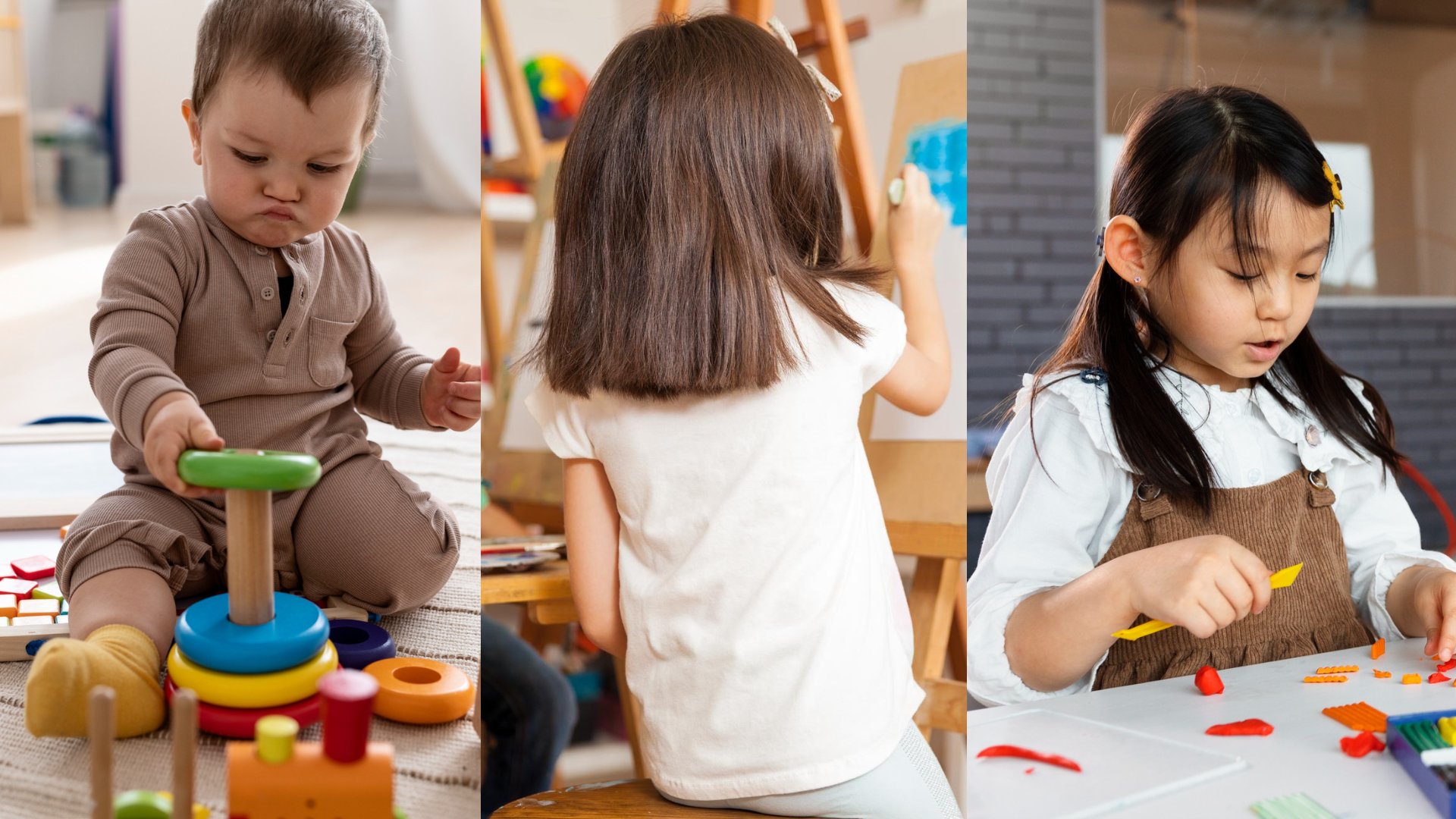
One of the most common questions modern parents ask is:
“Is it too late to start Montessori?”
Short answer: Nope.
Long answer: Montessori is for every age—from infancy to adolescence—and it’s never too late to begin.
Montessori for Babies (0–1 year)
Yes, it can start this early—but don’t panic. You don’t need to make your nursery Pinterest-perfect.
What it looks like:
Why it matters:
Even infants are developing focus, trust, and independence. Montessori gives them the space to explore safely and at their own pace.
Montessori for Toddlers (1–3 years)
This is one of the most ideal times to introduce Montessori, because toddlers crave autonomy—and fight like hell when they don’t get it.
What it looks like:
Key mindset:
Toddlers don’t want control over you—they want control over themselves. Montessori helps them get it in safe, appropriate ways.
Montessori for Preschoolers (3–6 years)
This is the golden age of Montessori classrooms, but it works beautifully at home too—even if your child is in public school or daycare.
What it looks like:
You might say:
“You can play outside or do puzzles—what feels right for you?”
“You poured the water all by yourself. You worked really hard.”
Want to dig deeper? Many of these preschool activities also build early problem-solving and logic skills. See how Montessori naturally connects to STEM learning.
Montessori for School-Age Kids (6–9 years)
Most people think Montessori stops once formal school starts. Not true.
At this stage, focus shifts to:
At home:
Let them take the lead on getting ready for school, packing bags, even planning meals. Resist jumping in unless safety’s at risk.
Montessori for Tweens and Teens (10+ years)
Yes—Montessori applies here too.
It just looks less like toy shelves and more like real-world preparation.
Key themes:
Think:
Instead of constant checklists and punishments, Montessori teens co-create routines, reflect on choices, and take increasing responsibility.
“But I Missed the Window…”
Let’s kill this myth right now.
You didn’t miss anything.
You don’t need to start at birth to raise a calm, capable, curious kid.
Montessori isn’t a timeline—it’s a toolkit. And you can open it anytime.
Whether your child is two or twelve, it’s never too late to:
So forget the guilt. The Montessori method grows with your child — and works for parents too.
Do You Really Need the Toys and the Training?
Let’s get brutally honest:
Most people think Montessori = expensive wooden toys + teacher training + minimalist neutrals.
That’s the Pinterest version. It’s also completely optional.
You do not need to spend hundreds on “Montessori” toys or have a diploma to use this method.
So What Actually Matters?
Forget the labels. Here’s what makes something Montessori-aligned:
Example:
That $120 wooden rainbow? Gorgeous.
But if your toddler just throws it or stares at it… is it really better than blocks they actually use to build?
“But Am I Doing It Right?”
This mindset kills more curiosity and confidence than any toy ever will.
Montessori at home isn’t about perfection.
It’s about intentionality.
You don’t need to recreate a classroom.
You don’t need a shelf of hand-crafted toys or a strict curriculum.
You just need to ask better questions:
That’s the core of Montessori.
What to Spend On (If You Want To)
If you’re looking to invest, prioritize things that support independence and real-life skills. Think:
You can DIY or thrift most of these. Or borrow. Or skip them altogether.
Montessori at Home Is a Mindset, Not a Shopping List
A minimalist toy shelf is nice.
A calm, capable child who feels trusted? Way better.
So before you buy anything, ask:
“Will this help my child do something for themselves—or is it just for me to feel like I’m ‘doing Montessori’?”
Chances are, your home already has everything you need.
Montessori Myths That Moms Still Hear
If you’ve ever thought “Montessori sounds great, but…” — this section is for you.
Because a lot of what stops parents from trying Montessori at home is based on stuff that simply isn’t true. Let’s clear it up.
Myth #1: “Montessori means no rules.”
Nope. Montessori isn’t a free-for-all.
In fact, freedom within limits is one of its core principles. Kids are free to explore, choose, and act — within clear boundaries that keep everyone safe and respectful.
So no, your toddler doesn’t get to dump water on the floor just because they’re “exploring.”
They get to pour it carefully because they’ve been taught how, and they’re trusted to try.
Montessori is about discipline, not control. Big difference.
Myth #2: “Montessori kids never use screens.”
Montessori started in 1907. Of course it didn’t include screens.
But today? Modern Montessori homes set thoughtful boundaries around tech.
Some are fully screen-free. Others use screen time selectively — for learning, connection, or creativity — not just passive entertainment.
For a calmer tech balance: If you want to take a more intentional approach to technology in your home, this guide to raising kids in the digital age walks you through practical ways to keep screens in check.
Not sure how much is too much? This quick breakdown of healthy screen time can help you set limits that actually work for your child’s age and stage.
You don’t have to ban screens completely to follow Montessori.
But you do need to ask:
“Is this helping my child grow or just keeping them quiet?”
That question alone puts you ahead of the curve.
Myth #3: “It’s only for young kids.”
Montessori starts in early childhood — but it doesn’t end there.
The approach continues through elementary and even high school in many Montessori schools.
The method grows with your child:
Montessori isn’t a phase. It’s a way of helping kids learn how to learn.
For a comprehensive understanding of the Montessori method and its core principles as applied in a school setting, please refer to our guide, .”What Is a Montessori School? A Practical Guide for Parents
Myth #4: “It’s too rigid / too loose.”
Some people think Montessori is overly strict and structured. Others think it’s too child-led and chaotic.
The truth? It’s a balance.
There’s structure, but it’s built around observation and choice.
There are routines, but they’re flexible and child-centered.
Montessori guides don’t bark orders or hover. But they don’t let kids run the show, either.
They step in when needed, and step back when it’s time to let the child lead.
That’s the art of it.
“What If I Don’t Get It Perfect?”
Good. You won’t. Nobody does.
Montessori isn’t a checklist — it’s a lens.
You’ll try. You’ll mess up. You’ll learn. Just like your kid.
Progress over perfection. Connection over control.
If that sounds like your kind of parenting…
You’re already on the right track.
How to Start Using Montessori Today (Even If You’re Busy, Overwhelmed, or Unsure)
Let’s be honest: Most parents don’t have the time, money, or mental energy to “do Montessori perfectly.” That’s fine. Montessori isn’t about perfection — it’s about being intentional.
You don’t need to turn your home into a classroom. You don’t need all wooden toys. You just need to start where you are.
Here’s how.
Step 1: Shift Your Lens, Not Your Lifestyle
Start by seeing your child through the Montessori lens. That means asking:
Example:
Instead of dressing your toddler every morning, try saying, “Do you want to put on your shirt or pants first?”
That’s a Montessori win — right there in your hallway chaos.
Step 2: Set Up a “Yes Space” for Independence
Montessori environments are built for kids to act independently. You don’t need fancy shelves. You do need a setup that says:
“You can do this without me hovering.”
Try this:
Small changes = big freedom. And that freedom leads to focus, confidence, and fewer power struggles.
On a budget? You don’t need pricey materials to make this work. Here are our favorite Montessori toys under $30 that still support independence and focus.
Step 3: Watch What Happens — Then Adjust
Observation is your secret weapon.
Montessori teachers don’t rush in to fix everything — they watch first, then step in with just the right nudge. You can do the same.
Try this:
This one habit can completely change how you parent.
Step 4: Try One Montessori-Friendly Activity a Day
You don’t need a full curriculum. Just pick one thing to do together each day:
That’s it. No printables, no pressure. Just real-life learning, built into your day.
Want a smoother daily flow? These practical Montessori rhythm tips can help you create consistency without overcomplicating your schedule.
“But I Don’t Have Time for This”
If you’re thinking, “I barely have time to shower, let alone set up Montessori trays,”—I hear you.
Here’s the truth:
Montessori isn’t something extra you do.
It’s a calmer, more connected way to do what you’re already doing.
Feeding, cleaning, playing, parenting — all of it can be Montessori, if you slow down and let your child take part.
So don’t add more to your plate. Just invite your child into the things you’re already doing — and watch what happens.
FAQ: Montessori for Modern Moms
What is the Montessori method in simple terms?
Montessori is a way of teaching and parenting that gives kids freedom to explore and learn at their own pace, in an environment set up for independence and respect. It uses real-life tasks, hands-on activities, and clear boundaries to build confidence and focus.
Is Montessori only for preschool?
No. Montessori works for all ages — from babies to teens — by adjusting activities and responsibilities to match each stage of development.
How do I start Montessori at home without buying expensive toys?
Begin with what you have. Make everyday items accessible (cups, snacks, clothes), involve your child in real tasks (pouring water, folding towels), and limit toys to a few purposeful choices.
Do Montessori kids use technology?
Yes — but with purpose. Montessori homes use tech intentionally, not for mindless entertainment.
Wondering how it all fits? Here’s how Montessori and tech can work together in a modern, screen-filled home.
Does Montessori mean no discipline?
Montessori uses respectful, consistent boundaries. Kids are free to choose within limits, and learn through natural consequences instead of bribes or punishments.
Final Thoughts: Montessori for Real Life, Not Just Instagram
Let’s cut the fluff.
Montessori isn’t about beige playrooms or curated shelves. It’s not about being a “Pinterest mom” or recreating a preschool in your living room.
It’s about respecting your child’s need to grow, learn, and do — on their terms, at their pace, in their own way.
And that? That’s something you can build into your real life, right now.
What Montessori Really Looks Like for the Modern Mom
It looks like:
Not always pretty. Not always smooth. But real. And deeply worth it.
Start Small. Stay Curious. Drop the Guilt.
You don’t need a full Montessori setup. You don’t need the perfect toys. You don’t need a certification or a teacher’s guide.
You just need to pay attention.
To your child.
To what they’re ready for.
To what they’re trying to tell you with their behavior.
The more you trust them, the more they rise to it.
The more you slow down, the more you both connect.
The more you make space for their independence, the more yours comes back too.
Your Next Step
If this spoke to you, pick one thing from this article and try it tomorrow. Just one. That’s how real change starts — not with a system, but with a shift.
And if you’re curious about going deeper, keep exploring. Montessori is a deep well. But you don’t have to dive in all at once. You just need to begin.
Bonus for Later: Montessori Doesn’t End at Preschool
The Montessori mindset grows with your child — through school age, tween years, and beyond.
Future posts will dive into what Montessori looks like for older kids and busy families. (Stay tuned.)
You don’t need to do it all. You just need to start.
Because when your child is seen, capable, and calm — your whole home feels more like that too.
Save it. Share it. Send it.
Found this helpful? Save this article. Share it with your mom group.
Or send it to a mom who’s figuring out Montessori without the Pinterest pressure.

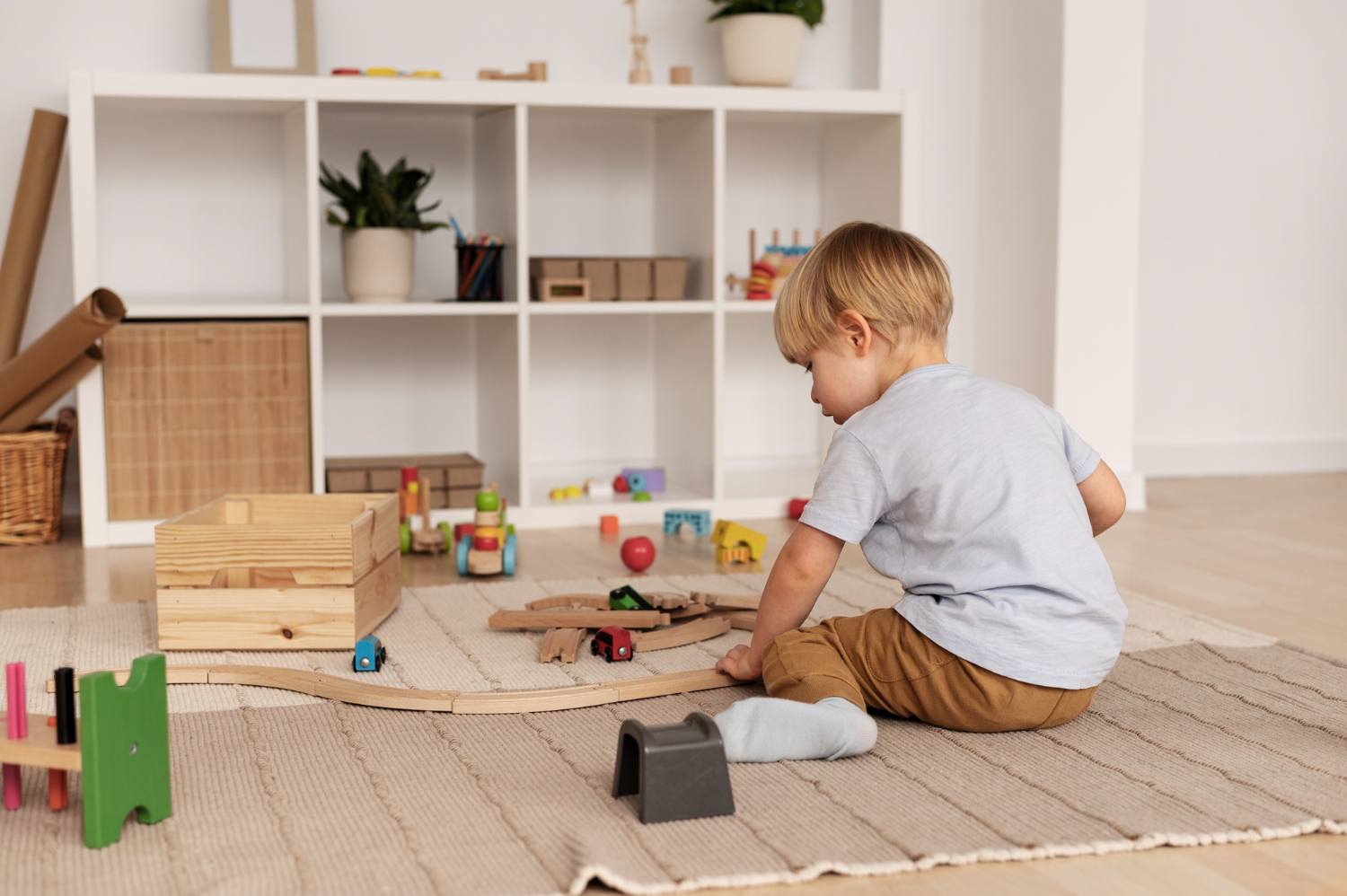
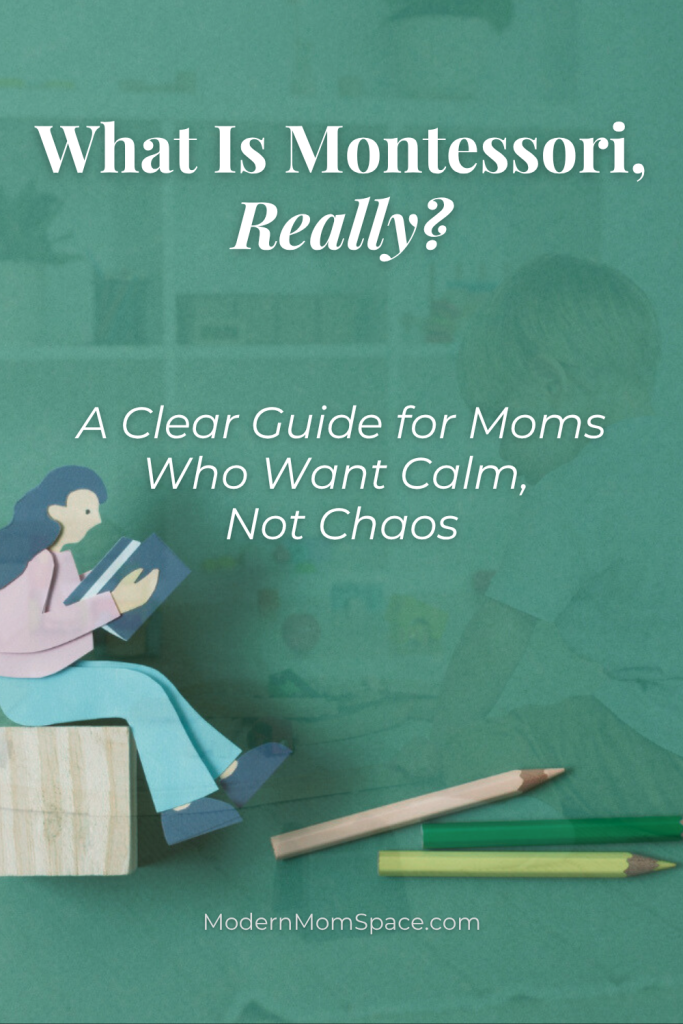
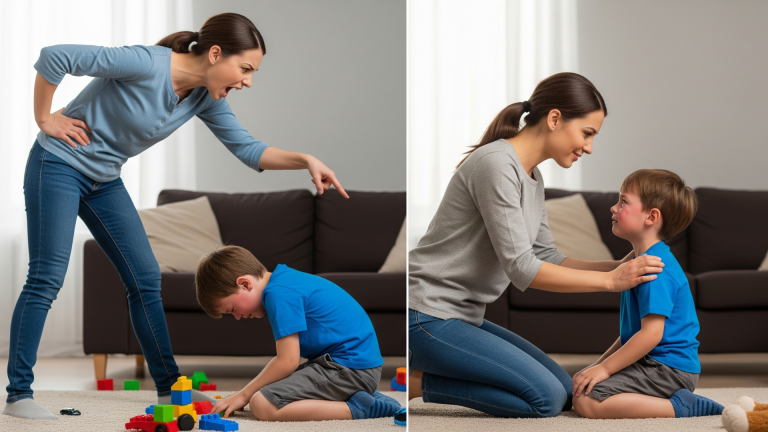

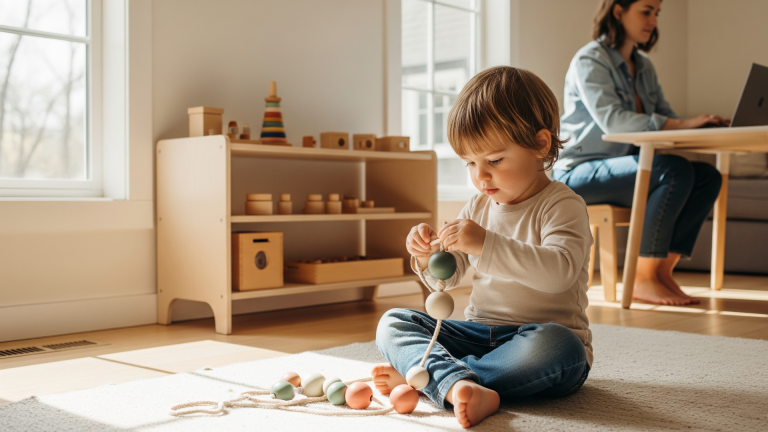

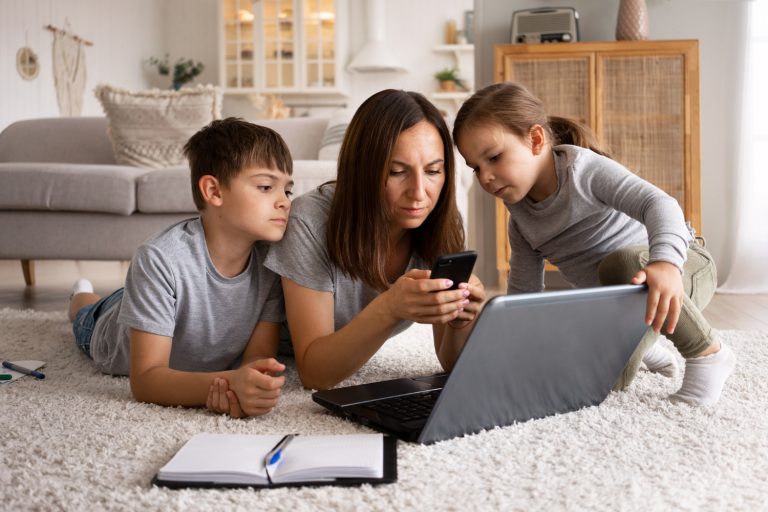

Nice article
Thanks